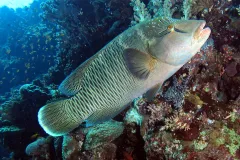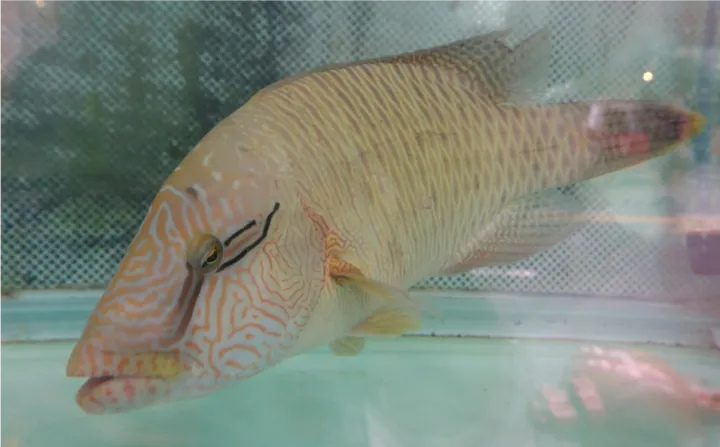An App Helps Scientists Combat Illegal Fish Trade

Relationships often begin with the locking of eyes. For Yvonne Sadovy, it was a meaningful stare with a fish.
As a newcomer to Hong Kong in the early 1990s and in need of a research topic for her new position as a marine scientist at the University of Hong Kong, Sadovy took to the local fish markets for ideas. There, she was struck by a peculiar fish. “It caught my eye—there was just something about it, it had a different behavior to most fish I watch, it actually looked at me, it met my eye. Even after years studying fish in the field I don’t remember a fish looking at me in such a way. It got me curious, plus I didn’t know what it was,” says Sadovy.
This fish, she found out, was a juvenile humphead wrasse. Fast forward to the present, and Sadovy has spent over 20 years studying this fish and working to conserve its populations.
In small aquariums among the bustling market streets of Hong Kong you are sure to find several, young humphead wrasse swimming in tanks. These tropical fish (also called the Napoleon fish) have intricate facial markings (one of their other, many, names is the Maori wrasse because of these markings) that are unique from fish to fish. Larger fish have a bulbous bump on the top of their head that gives them a comical appearance—and another inspiration for one of their many names. Most scientists and divers are familiar with the large males, but the juveniles are not as well known. Purchasing and serving humphead wrasse is a sign of wealth and status in China because the fish is so expensive. One can cost many hundreds of US dollars, and so they are heavily sought after by the growing Chinese middle class. Fish at the retail markets are often a product of an illegal fish trade. In fact, the majority of fish on sale are probably illegally traded.
Population surveys by scientists compiled by Sadovy and colleagues in 2003 revealed that humphead wrasse were in trouble in many countries of its broad geographic range. Fishing had reduced their population size by at least 50 percent over 30 years. Humphead wrasse have a special reproductive biology that makes them especially susceptible to overfishing. All humphead wrasse begin their sexual lives as females, and only once the local male dies does a female fish transform into a male. Many wrasse never get the chance to become a male though, because fish are most desirable for the market when they are the size of a dinner plate—too small to reach male status; males only start to appear about 80 cm length or so and the biggest plate size is about 45 cm.
“Every way I turned, everywhere I looked, every piece of information I that came up with, indicated they were threatened, and if nothing changed it would put them at risk of extinction in many areas. It’s like this fish had all the wrong things going for it,” says Sadovy.
Realizing Hong Kong’s appetite for humphead wrasse was unsustainable, the city imposed a permit system on the species in 2005. Now, every humphead that enters the city must be accompanied by an official import permit, issued by the exporting country. Possession of a fish requires yet another permit and transporting the fish to other, mainland, Chinese cities a third, under Hong Kong law. Countries where the fish are caught, like Indonesia and Malaysia, have strict export policies—Indonesia determines the quota on a year-to-year basis (currently it’s under 2,000) while Malaysia outright banned the export of humphead wrasse in 2010 when it realized there were so few in national waters.
But despite an endangered species designation on the IUCN Red List and by CITES for international trade, the need for a permit to sell the fish, and export restrictions in countries that historically supplied the Hong Kong markets, the humphead wrasse continues to find its way illegally to Hong Kong in unsustainable numbers. Between 2014 and 2015, 434 humphead wrasse were legally imported into Hong Kong according to official records, however, research surveys of retail outlets indicate that several thousand were actually imported. Sadovy estimated that at least 50 percent of the fish shown at the markets were illegal at that time.
Some are smuggled in on Hong Kong registered vessels. As domestic vessels, they are not required to check in with the Hong Kong marine department, unlike foreign vessels and are easy to miss by authorities. Some fish are flown in and mixed in tanks with other groupers, labeled as groupers, and therefore escape detection. And once they reach Hong Kong some are taken directly to high-end restaurants and hotels, out of site from regulating officials or slipped into the mainland over the border. Although enforcement improved after Sadovy revealed the level of illegal trade, and far fewer fish were seen on sale, illegal trade continued.
Now scientists and enforcement officers are turning to a cell phone app to help them combat the illegal fish trade. Recall that the humphead wrasse has intricate facial markings that distinguish individual fish—much like a human fingerprint. Using a database of imported fish photographs (all legally traded humphead wrasse are photographed by government staff when they are brought into the city), any person can take a picture of the fish in the tank to see if they are being sold legally. This puts the power in the consumer’s hand and allows enforcement officers to compare the picture with those from legally imported fish to easily prove when fish seen at the market are illegal.
The idea came to Sadovy as she passed a restaurant near her work that continually displayed a single humphead wrasse in a tank. Despite the fact that the species can only survive living in a tank for a few weeks there was always one fish on display, even after several months. “I thought, this is odd, how can this be the same fish I saw months ago? So, I started taking pictures of it. I took pictures almost every day on the way to and from work.”
After 3 months the evidence became clear. Using the fish’s distinct facial markings, an identifying technique often used to track whales and sharks, among other animals, Sadovy was able to determine that over that time period 14 different fish lived in the tank. When the restaurant owner was directly asked if he had a license to possess the fish, as part of a Radio-TV Hong Kong documentary, he said that he was still waiting for it. Humpheads were never seen again in the tank after that.
With a facial recognition app in hand, authorities would be able to determine whether a fish in a tank is the fish tied to the import permit. Currently, businesses are supposed to report when they sell a humphead wrasse but often they don’t, so when a new fish is acquired they can easily pass it off as the same fish. In this way, fish are ‘laundered’ with new fish which replace them. The app can also be used to follow all fish in individual tanks and detect laundering.
But Sadovy is hopeful that will soon change. The app is still in its developmental phase, but she’s seen that Hong Kong officials are keen to use the app and some of her students who once viewed the fish as just research subjects now give the fish they work on individual names. And there have been several prosecutions for laundering and selling fish with no permits.
“These fish all look the same at first, but you can start seeing the pattern differences, and they’re very marked, you begin to think of them as individuals and it begins to shift your thinking about them.”



